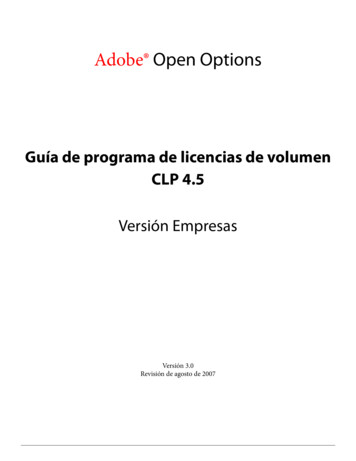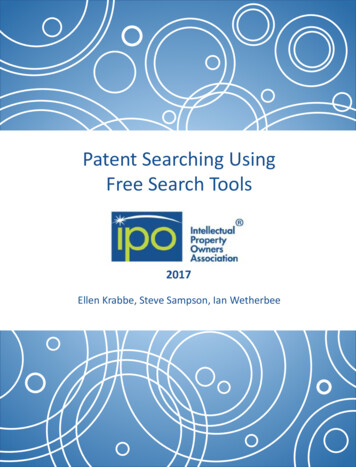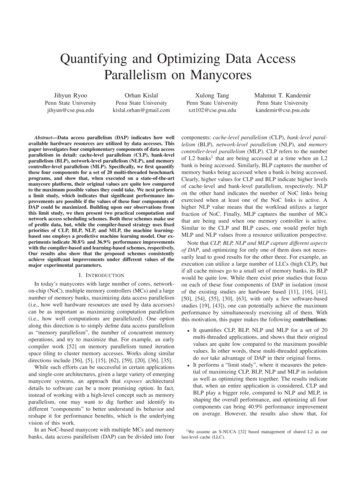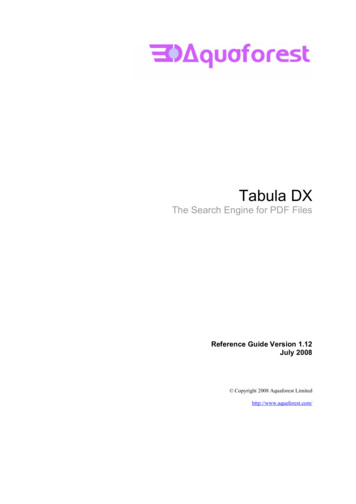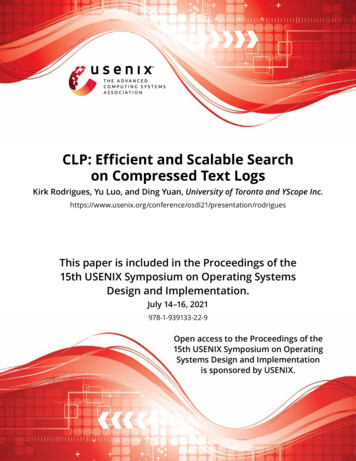
Transcription
CLP: Efficient and Scalable Searchon Compressed Text LogsKirk Rodrigues, Yu Luo, and Ding Yuan, University of Toronto and YScope ntation/rodriguesThis paper is included in the Proceedings of the15th USENIX Symposium on Operating SystemsDesign and Implementation.July 14–16, 2021978-1-939133-22-9Open access to the Proceedings of the15th USENIX Symposium on OperatingSystems Design and Implementationis sponsored by USENIX.
CLP: Efficient and Scalable Search on Compressed Text LogsKirk Rodrigues, Yu Luo, Ding YuanUniversity of Toronto & YScope Inc.AbstractThis paper presents the design and implementation of CLP, atool capable of losslessly compressing unstructured text logswhile enabling fast searches directly on the compressed data.Log search and log archiving, despite being critical problems,are mutually exclusive. Widely used log-search tools likeElasticsearch and Splunk Enterprise index the logs to providefast search performance, yet the size of the index is within thesame order of magnitude as the raw log size. Commonly usedlog archival and compression tools like Gzip provide highcompression ratio, yet searching archived logs is a slow andpainful process as it first requires decompressing the logs. Incontrast, CLP achieves significantly higher compression ratiothan all commonly used compressors, yet delivers fast searchperformance that is comparable or even better than Elasticsearch and Splunk Enterprise. In addition, CLP outperformsElasticsearch and Splunk Enterprise’s log ingestion performance by over 13x, and we show CLP scales to petabytes oflogs. CLP’s gains come from using a tuned, domain-specificcompression and search algorithm that exploits the significantamount of repetition in text logs. Hence, CLP enables efficient search and analytics on archived logs, something thatwas impossible without it.1IntroductionToday, technology companies easily generate petabytes of logdata per day. For example, eBay reported generating 1.2 PBof logs per day in 2018 [46]. This data can be used for avariety of important use cases including security forensics,business insights, trend analysis, resource optimization, andso on. Since many of these cases benefit from large amountsof data, companies strive to retain their logs for as long aspossible. Moreover, some industries (e.g., health services) arerequired by law to store their logs for up to six years [5].However, storing and analyzing a large amount of log dataimpose significant costs. Although it is difficult to obtaintransparent, publicly available information about companies’storage costs, studies have estimated that a lower bound forcapital depreciation and operational costs could be on theorder of two cents per gigabyte, per month [7]. For a companylike eBay, this translates to over 50 million to store the logsgenerated in a year, and nearly 500 million to store the logsUSENIX Associationgenerated over three years. As a result, the log managementindustry has grown incredibly large.Currently, Elastic [2] and Splunk [4] are two of the largestcompanies in the industry. In just their last fiscal year, Elasticreported revenue of 428 million with a total of 11,300 customers [14] while Splunk reported revenue of 2.359 billionwith 19,400 customers [36]. Moreover, their offerings, Elasticsearch [15] and Splunk Enterprise [37], are used by severallarge companies like eBay, Verizon, and Netflix.Tools like Splunk Enterprise and Elasticsearch operate bygenerating external indexes on the log messages during ingestion. Then in response to a query, these tools can quicklysearch the indexes corresponding to the logs, decompressingonly the chunks of data that may contain logs matching thesearch phrase. Elasticsearch, for example, is built around ageneral-purpose search engine Lucene [42]. However, thisapproach comes at the cost of a large amount of storage spaceand memory usage. Although these tools apply light compression to the logs, the indexes often consume an amount ofspace that is the same order of magnitude as the raw logs’ size;furthermore, these indexes must be kept mostly in memory oron fast random access storage in order to be fully effective.Thus, Splunk Enterprise and Elasticsearch users with largeamounts of data can only afford to retain their indexed logsfor a short period, typically a few weeks [8].To avoid discarding logs at the end of their retention period, companies can use industry-standard compression toolslike Gzip [21] to archive them, potentially gaining a 95%reduction in storage costs. In addition, recent advancementsin compression algorithms like Zstandard [16] bring significantly improved compression and decompression speeds.However, these general-purpose compressors are not designedwith search (on compressed data) in mind. They typically encode duplicates in length-distance pairs [40, 49], i.e., startingfrom the current position, if the next L (length) charactersare the same as the ones starting at D (distance) behind, wecan encode the next L characters with (D, L), and directlyembed this pair at the current position, an approach known asan internal macro scheme [40]. Performing searches on thisarchived data, however, is painful and slow—the tool needsto sequentially scan the entire data set, essentially decompressing the data. This leads to the unfortunate reality that loganalysis and log archiving are generally mutually exclusive.15th USENIX Symposium on Operating Systems Design and Implementation183
To bridge this gap, we have created a method for losslesslog compression that still allows efficient searches on thecompressed data, without the need to decompress every logmessage. It works by combining a domain-specific compression and search algorithm with a lightweight general-purposecompression algorithm. The former allows us to achieve amodest amount of compression without sacrificing searchperformance. The latter increases the overall compressionratio significantly with a minor impact on compression anddecompression performance.The domain-specific compression algorithm uses an external macro scheme, i.e., it extracts the duplicated patternsinto a dictionary that is stored separately from the encodedlog messages [40]. A search query will be processed by firstsearching in the dictionary, and then searching those encodedmessages for which the dictionary search suggests possiblematches. This method relies on the simple observation that today’s software logs contain a large amount of repetitive statictext. By systematically separating the static text from the variable values, the algorithm can deduplicate the static text intoa dictionary. Applying a similar process to the variable values,the algorithm converts an entire log message into a series ofintegers and dictionary entries that are easily compressibleusing a general-purpose compressor.The search process similarly encodes the query string as acompressed message and searches for a match; but supportingqueries with wildcards makes this process significantly moreinvolved. For example, a wildcard can make it ambiguouswhether a token is part of the message’s static text or whetherit is part of a variable. As a result, the algorithm must considerthe effect of wildcards at every stage of the encoding andsearch process.Using this method of compression and search, we have builtan end-to-end log management tool, CLP1 , that enables realtime data ingestion, search, analytics, and alerting on top of anentire history of logs. CLP is agnostic to the format of logs andcan ingest heterogeneous and unstructured logs. As a result,CLP is capable of reducing the size of currently archived logswhile simultaneously enabling search and analytics on thecompressed data.Our evaluation shows that CLP’s compression ratio is significantly higher compared to all tested compressors (e.g., 2xof Gzip), while enabling efficient search on compressed data.This comparison even includes industry-standard tools like Zstandard at their highest (and slowest) compression level. Furthermore, CLP’s search speed outperforms commonly usedsequential search tools on compressed data by 8x in a widerange of queries. Even compared with index-based log-searchtools Splunk Enterprise and Elasticsearch, CLP outperformsthem by 4.2x and 1.3x respectively. CLP’s distributed architecture further allows it to scale to petabytes of logs. CLP isopen-sourced and can be found at https://yscope.com. It1 CLP184stands for Compressed Log Processoris also hosted in the cloud so users can use it as a service.CLP’s main limitation is that its algorithm is designed primarily for text logs. This is not a problem in the vast majorityof software logs that we have seen, but we acknowledge thatthere are projects that log primarily binary or structured data.However, if converted to text with a verbose schema, theselogs can be compressed and searched using CLP withoutadditional overhead.The rest of this paper is organized as follows. §2 describesthe core elements of CLP’s design for compression and search.§3 details how CLP handles the various intricacies of handling wildcards and patterns of variables. §4 describes oursyntax for variable patterns. §5 explains how CLP can cachequeries in reusable manner for performance. §6 describes acharacteristic of CLP’s compression format that can be usedfor privacy control. §7 discusses the evaluation results of CLPcompared with other tools. Finally, §8 discusses related work,before we conclude in §9.2Design OverviewCLP is a complete end-to-end system for ingesting, archiving, searching, and analyzing log messages. Figure 1 showsan overview of CLP’s compression and search architecture.Within the compression architecture, logs can be ingested either through CLP’s real-time ingestion engine (e.g., from rsyslog, Fluentd, Logstash, etc.) or by reading them directly fromlocal or cloud storage (e.g., Amazon S3 [29]). The compression nodes compress the ingested logs into a set of archives.Users can access the compressed logs transparently using aUnix terminal through the Filesystem in Userspace (FUSE)layer or by querying them through CLP’s search interface.CLP allows users to query their logs using a wildcardsearch followed by a series of operators. An example query isshown in Figure 2, containing four commands pipelined witha Unix-style pipe (‘ ’). The first command returns all log messages matching the search phrase (‘*’ is a wildcard characterthat matches zero or more characters). Results are piped to theregex operator which uses a regular expression to extract thecontainer ID and operation runtime, storing them in user defined variables. Next, the filter operator filters for runtimesthat are above “0.1”. Finally, the unique operator generatesa list of unique container IDs that satisfy the filter. Overall,this query returns the unique containers where the assignmentoperation took over 0.1 seconds in the 172.128.*.* subnet.We refer to this type of query as a pipelined query.CLP’s search architecture supports pipelined queries bycombining search nodes with a MapReduce-style [11] framework. CLP receives queries through its web UI or PythonAPIs. Queries are first serviced by the search nodes whichperform a wildcard search on the archives. Results are thenforwarded to the operator nodes, after which the final resultsare sent back to the user. Users can also create alerts thattrigger when newly added log messages satisfy a saved query.15th USENIX Symposium on Operating Systems Design and ImplementationUSENIX Association
Text logsDeduplicate & EncodeLightweight ogtype IDLogtype IDLogtype IDVariable IDs & valuesVariable IDs & valuesVariable IDs & valuesCommand LineCompressed Data FormatFigure 1: Overall architecture of CLP."Task * assigned to container*:172.128" regex "(? container container \d ).* took (? runtime \d )" filter float(runtime) 0.1 unique containerFigure 2: A query example. CLP operator and keywords are in blue,and user-defined variables are in red.Note that because search is the first stage of every query, it isalso the most important for performance since it operates oncompressed data and all other stages operate on the decompressed data it outputs.We aim to satisfy three objectives with this design: First,logs should be compressed losslessly so that users can deletetheir original logs without worrying that CLP would destructively transform them (e.g., by changing the precision offloating-point values). Second, users should be able to searchtheir logs for any value, in contrast to index-based search toolswhich typically only allow searches for indexed values. Forexample, unlike grep-like tools that respect all characters ina search phrase, indexed-based search tools typically ignorepunctuation and stop words (e.g., “and”). Finally, CLP shouldbe performant and scalable so that users can use it to ingestand search a large amount of log data while saving on storagecosts. By satisfying these objectives, we aim to bridge thegap between conventional log archival and search, e.g., usinggzip and grep, and large-scale log analysis, e.g., using SplunkEnterprise or Elasticsearch.The core of CLP is implemented in C for performancewhile higher-level functionality is built in a variety of languages from Java to JavaScript.2.1CompressionCLP’s compression consists of two steps: first it deduplicateshighly repetitive parts of each log message and encodes themin a special format, then it applies a lightweight compressorto the encoded data, further reducing its size. This sectionfocuses on explaining the first step.CLP splits each message into three pieces: 1) the log type,which is typically the static text that is highly repetitive, 2)variable values, and 3) the timestamp (if the message contains one). CLP further separates variable values into twoUSENIX Associationcategories: those that are repetitive, such as various identifiers(e.g., a username), and those that are not (e.g., a job’s completion time). We refer to the former as dictionary variablessince CLP extracts and stores them in a dictionary; the latter are called non-dictionary variables. Figure 3 shows a logmessage and how CLP converts it into a compressed form.Overall, this requires parsing the message to extract the aforementioned components and then compressing it using CLP’sdomain-specific compression algorithm.2.1.1Parsing MessagesCLP parses logs using a set of user-specified rules for matching variables. For example, Figure 4 lists a set of rules thatcan be used to parse the example log message. Lines 3–5contain three dictionary variable schemas and line 8 containsa non-dictionary variable schema. This is similar to toolslike Elasticsearch and Splunk Enterprise that either provideapplication-specific parsing rules or ask users to write theirown. CLP provides a default set of schemas that can be applied universally to all log formats, or users can optimizethem to achieve better compression and faster searches ontheir workloads.One challenge with using variable schemas is that they canmatch pieces of a log message in multiple ways. For instance,“172.128.0.41” could match the schema for an IP address orit could match two instances of the floating point numberschema, joined by a period. However, we have observed thatdevelopers typically separate different variable values withone or more delimiter characters. Furthermore, they also usedelimiters to separate variable values from static tokens in thelog type. We call this the tokenization rule, which states thata token is inseparable. That is, an entire token is either a variable value or part of the log type. In this case, “172.128.0.41”will be treated as a single token, so it can only match an IP address instead of two floating point numbers joined by a period.Accordingly, CLP allows users to specify a set of delimitersthat ensures their schemas only match variables in a way thatrespects the tokenization rule.To parse a log message, CLP first parses and encodes themessage’s timestamp as milliseconds from the Unix epoch.CLP then tokenizes the log message using the user-specified15th USENIX Symposium on Operating Systems Design and Implementation185
Log messageVariabledictionary2020-01-02T03:04:05.006 INFO Task task 12 assigned to container: [NodeAddress:172.128.0.41, ContainerID:container 15], operation took 0.335 secondsID012ID8Variable valuetask 12Segments.ID9Variable value172.128.0.41Segments.ID9Variable valuecontainer 15Segments.Log typeINFO Task \x11\x00 assigned to container: [NodeAddress:\x11\x01,ContainerID:\x11\x02], operation took \x12\x13 secondsSegments.Schematask \d \d{1,3}\.\d{1,3}\.\d{1,3}\.\d{1,3}container \d Log 5006Log type ID4PtrVariable values8 9 9 0x3FD570A3D70A3D71Figure 3: A log message and its encoding. Dictionary variables are in blue; Non-dictionary variables are in orange.delimiters : " [] ,: "dictionary variables :" task \ d "# Task ID" \ d {1 ,3}\.\ d {1 ,3}\.\ d {1 ,3}\.\ d {1 ,3} " # IP" container \ d "# Container ID123456non dictionary variables :" \ d \.\ d " as floating point number78Figure 4: Schemas used to parse the example in Figure 3.delimiters. For each token, CLP compares it with each variable schema to determine whether it is a variable value. InFigure 3, CLP identifies three dictionary variables in the logmessage—“task 12”, “172.128.0.41”, and “container 15”—and a non-dictionary variable value, “0.335”.2.1.2Compressing MessagesOnce parsed, the dictionary variables are stored in a twolevel variable dictionary, referred to as a vDict. The first levelmaps each dictionary variable schema to a unique ID. Eachschema is also mapped to a pointer that points to the secondlevel of the vDict, where the actual variable value is stored.In Figure 3, the schemas for the task ID, IP address, andcontainer ID are mapped to IDs 0, 1, and 2 in the first level,and the actual variable values are stored in the second level.Non-dictionary variable values are stored directly in theencoded log message if possible. For example, “0.335” is encoded using the IEEE-754 standard [1] and stored as a 64-bitvalue in the encoded message. CLP currently supports encoding floating point numbers and integers as non-dictionaryvariables. If a non-dictionary variable cannot be encoded precisely within 64-bits (e.g., its value overflows), it is stored asa dictionary variable instead. Non-dictionary variables tend186to be unique values like counters, so they do not benefit frombeing stored in a dictionary. We use a fixed-width 64-bitencoding instead of a variable-width encoding because it issimple to implement, and the space inefficiency is diminishedby the lightweight compressor applied to the encoded data.The remaining portion of the log message is treated asbeing part of the log type, where variable values are replacedwith special placeholder characters. Each unique log type isstored in the log type dictionary, or ltDict, and is indexed byan ID. CLP uses byte ‘\x11’ to represent a dictionary variablevalue. The next one or more bytes after ‘\x11’ are an index intothe vDict’s first level, i.e., an index to the variable schema. InFigure 3, ‘\x00’, ‘\x01’, and ‘\x02’ in the log type are indicesto the three schemas for the task ID, IP address, and containerID in the vDict. CLP uses ‘\x12’ as the placeholder for afloating point non-dictionary value. The next byte, ‘\x13’, inthe log type indicates that there is one digit before and threedigits after the ‘.’ character in the raw log message, ensuringthe floating point value can be losslessly decompressed.Note that we could choose any bytes for the placeholdercharacters, but since ‘\x11’ and ‘\x12’ are not printable ASCIIcharacters, they are unlikely to appear in text logs. If they do,CLP will escape them before insertion into the log type.CLP outputs the encoded message as a tuple with threeelements as shown in Figure 3: a 64-bit timestamp, a 32bit log type ID, and a sequence of 64-bit variable IDs andencoded variable values.We have experimented with additional encoding schemesthat can further reduce the size of the encoded data, but decided not to adopt them due to their undesirable trade-off.For example, we could store variable IDs and non-dictionaryvariable values using a variable-length encoding, instead of afixed-length 64-bit encoding. We have also experimented withdelta encodings, run-length encodings, and so on. However,these would come at the cost of search performance since15th USENIX Symposium on Operating Systems Design and ImplementationUSENIX Association
Log file 1Log file 2TimestampsLog file 3Log typesVariablesFigure 5: Storing encoded messages in column-oriented manner. Itshows a segment that contains three encoded log files.it is faster to scan fixed-length values than variable-lengthvalues. Moreover, the space savings are negligible after thelightweight compressor is applied on the encoded data.2.1.3Decompressing MessagesCLP’s decompression process is generally a reversal of thecompression process. Given an encoded message, CLP usesthe message’s log type ID to find the corresponding log typein the ltDict. CLP then reconstructs the variable values andreplaces the placeholders in the log type. For example, CLP reconstructs the variable value “task 12” in Figure 3 as follows:the first ‘\x11’ in the log type indicates that it is a dictionaryvariable, so CLP uses the next byte, ‘\x00’ as an index into thefirst level of the vDict. CLP then uses the variable ID storedin the encoded message (8 in this case) to index the corresponding second level of the vDict, and restores the variablevalue “task 12”. Finally, CLP converts the timestamp back totext and inserts it into the message.2.1.4On-disk FormatFigure 1 also shows the on-disk format of CLP’s compressedlogs. CLP encodes each message and stores them in the sametemporal order as in the original log file. This ensures thefile can be losslessly decompressed. The encoded messagesare initially buffered in memory, and once the buffer reachesa certain size, they are compressed using Zstandard beforebeing written to disk, creating what we call a segment.Encoded messages are stored in a column-oriented manner [39], as shown in Figure 5—CLP stores the timestampcolumn of the messages from log file 1, then its log type IDs,and finally the variable IDs and values column, before storingthe three columns of the next log file. Storing columnar dataseries reduces data entropy within Zstandard’s compressionwindow, significantly improving compression ratio. In addition, columnar data-series can improve search performance:for instance, if users search for a message in a specific timerange, CLP can skip messages outside that time range by onlyscanning the timestamp column rather than all columns.Multiple segments further belong to an archive, where allsegments in an archive use the same log type and variabledictionaries. CLP automatically closes and creates a newarchive when the dictionaries reach a size threshold. Thisensures that the dictionaries do not grow too large such thatthey have non-negligible loading times for decompressionUSENIX Associationand search. CLP also compresses the dictionaries using thesame lightweight compressor applied to the segments.Each entry in the ltDict and the vDict’s second level alsohas a list of pointers to segments that contain the particular logtype or variable value. CLP is I/O bound reading segments, sothis serves the purpose of a coarse-grained search index. Weindex at the granularity of segments since any query that hasa hit in a segment requires the segment to be decompressedfrom its beginning to the matched message. Without the index,any search that matched a dictionary entry required searchingall segments in the archive.For each archive, CLP also stores metadata about the logfiles and directories that were compressed. For each file, themetadata contains the original filesystem path of the file, thenumber of log messages it contains, the starting and endingtimestamp of the messages in the file, the format of its timestamp (used to reconstruct the timestamp during decompression), and the segment that contains the compressed messagesfrom the log file. In addition, the metadata contains the threeoffsets in the segment corresponding to the starting locationsof the messages in this log file: one for each of the timestampcolumn, log type column, and variable column. These offsetsare used to speedup the search when users use search filters.For example, a user could search for filenames that matcha specific pattern, such as yarn.log (the log produced byYARN in a Hadoop cluster). Users can also specify the timerange of the search, so CLP will first filter log files based onthe starting and ending timestamps. In such cases, the metadata as well as the content in the data columns themselvesallow CLP to skip scanning parts of data columns or files.For directories, the metadata in the archive stores the pathsof any empty directory that was compressed. An empty directory may be indicative of missing logs or it may be namedafter an identifier that the user wishes to keep. Thus, to ensurelossless decompression, these paths must be stored.CLP also supports different compression modes that canoffer improved compression at the cost of a minor reductionin performance. This is achieved by changing the lightweightcompressor’s settings. CLP currently ships with three modes:“Default” that uses Zstandard at level 3 and is concurrentlyoptimized for compression speed and search performance;“Archive” that uses 7z-lzma at level 1 and offers higher compression with slightly reduced search performance; and finally,“Ultra” that uses 7z-lzma at level 9 and offers even higher compression with further reduced search performance. CLP canmigrate between these modes by simply decompressing andrecompressing the segment.2.2SearchGiven a search phrase, CLP processes it in the same waythat it compresses a log string: CLP tokenizes the phrase,extracts variable values, and constructs the log type. Next,CLP searches the archive’s dictionaries for the log type and15th USENIX Symposium on Operating Systems Design and Implementation187
#123456Log typeVariables"Task * assigned to container*:\x11\x01""Task * assigned to container*:\x12?""Task * assigned to container*:178.128*""Task * assigned to \x11\x02*:\x11\x01""172.128*" (IP address)"Task * assigned to \x11\x02*:\x12?""172.128*" (floating point num.)"Task * assigned to \x11\x02*:178.128*""172.128*" (IP address)"172.128*" (float num.)"container*" (container ID)CLP’s processingLog type, var. search, scan segmentsLog type search (no match)Log type search (no match)Log type search (no match)"container*" (container ID)Log type search (no match)"container*" (container ID)Log type search (no match)-Table 1: Processing of the search example in Figure 2. Each row is a sub-query generated by CLP.dictionary variables. If matches are found for the log type andall dictionary variables, CLP proceeds to search the segmentsfor encoded messages that contain the matching log type ID,dictionary variable IDs, and encoded non-dictionary variables.However, wildcards in the search phrase complicate thisprocess. CLP supports search phrases that can contain twotypes of wildcard characters: ‘*’ (henceforth referred to as a*-card) that can match zero or more characters and ‘?’ (henceforth referred to as as a ?-card) that matches any single character. First, it is nontrivial to tokenize a string with wildcards.For example, the string “Task*assigned” could be a single token or two tokens (“Task*” and “*assigned”) since a *-cardcan match both non-delimiter and delimiter characters. Furthermore, it is nontrivial to determine if a token with a wildcard matches a variable schema. Finally, without wildcards,a token will be unambiguously categorized as either a logtype, a dictionary variable, or a non-dictionary variable; butwith wildcards, a token could belong to multiple categories.We address the first two issues in Section 3 and continue adiscussion of the third challenge below.2.2.1Handling Ambiguous Tokensing “172.128*” as a floating point number, CLP does not knowthe value’s exact precision, so it inserts a ?-card to match allpossibilities. Sub-query 4–6 in Table 1 consider the cases that“container*” is treated as a dictionary variable container ID.Each sub-query will be processed in three steps. First, CLPsearches the ltDict for matching log type. Only when there isa matching log type, it proceeds to the next step of searchingthe vDict for the dictionary variables. And only when thereis at least one matching result for every dictionary variable,CLP proceeds to the third step. It takes the intersection ofthe segment indexes of the matching log type and dictionaryvariables, and for each of these segments, CLP decompressesthe segment and searches for encoded messages matching theencoded query. If any of the first two steps return no matchingresult, or the intersection of the segment indexes is empty,the sub-query processing returns with no match. Differentsub-queries will be processed in parallel.For the six sub-queries shown in Table 1, only the first subquery will exercise all three steps and return the matching logmessage shown in Figure 3. The processing of the other fivesub-queries will return after step one, because the generatedlog type does not match any log types in the ltDict (these logtypes are impossible).Consider the search command in Figure 2. CLP first inserts a*-card at the beginning and end of the search string, turning itinto a substring search to match user-expectations. Then aftertokenization, CLP recognizes the following tokens: “*Task”,“assigned”, “to”, “container*”, “172.128*”. Note that CLPdoes not consider a lone *-card as a token. For example, the*-card after “Task” is no
ing, searching, and analyzing log messages. Figure1shows an overview of CLP's compression and search architecture. Within the compression architecture, logs can be ingested ei-ther through CLP's real-time ingestion engine (e.g., from rsys-log, Fluentd, Logstash, etc.) or by reading them directly from local or cloud storage (e.g., Amazon S3 .
